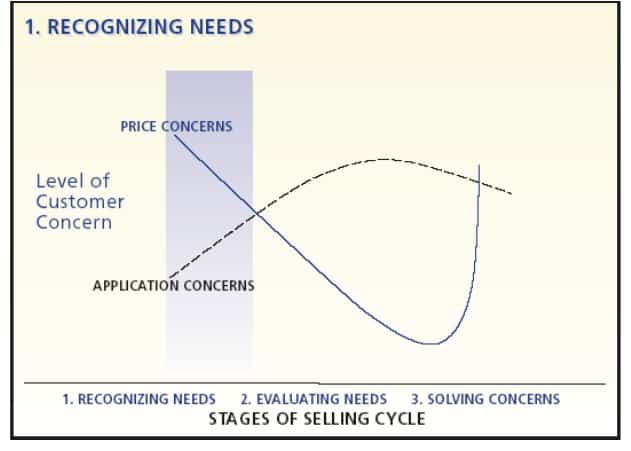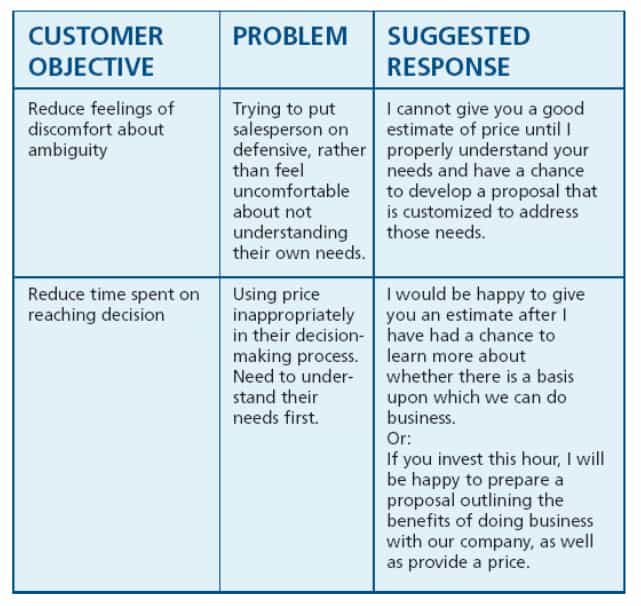Selling on Value Instead of Price (Part 1)
It’s an all-too-familiar predicament for salespeople – the customer who insists on knowing the price of a product long before the salesperson can determine that customer’s needs. Salespeople are constantly under pressure to reduce prices and, after a while, it can readily take a toll. Some salespeople become convinced that price is the driving force behind customer’s buying decisions. In same cases, this is true, but in our experience, it is usually other factors that are driving decisions.
To ensure that your sales team is selling on value, they must understand the sales process and how price plays itself out in each stage.
This is the first in a series of articles dedicated to helping salespeople sell on value instead of price.
It’s an all-too-familiar predicament for salespeople – the customer who insists on knowing the price of a product long before the salesperson can determine that customer’s needs.
Salespeople are constantly under pressure to reduce prices and, after a while, it can readily take a toll. Some salespeople become convinced that price is the driving force behind customer’s buying decisions. In same cases, this is true, but in our experience, it is usually other factors that are driving decisions.
To ensure that your sales team is selling on value, they must understand the sales process and how price plays itself out in each stage. For example, leading sales experts have identifi ed three stages that customers go through when they make a buying decision:
- Recognizing needs
- Evaluating alternatives
- Resolving concerns
Depending on the size and scope of the purchase, this process can happen in mere seconds, or it can take months and even years. Understanding the role that pricing plays in each stage is important knowledge, which helps salespeople navigate the rocky shoals of pricing more successfully. In this newsletter, we will focus on Stage 1 – Recognizing Needs, and provide some effective responses for salespeople to use when faced with customers who are stuck on price.
Stage 1 – Recognizing Needs
The first stage of the buying process is recognizing needs. At this stage, customers are becoming aware of whether or not they have a need. If they recognize they have a need, and they care about it enough, then they will choose to do something about it. An effective salesperson’s job at this stage is to accomplish three things:
- Uncover dissatisfaction – do customers in fact have a need? Are they dissatisfi ed with their current situation, or would they be if they knew more about your offering?
- Build on their dissatisfaction – fully develop the need to a point that causes the account to act.
- Selectively channel dissatisfaction – focus on uncovering dissatisfaction in those areas in which your offering provides the customer with the best solution.
This all sounds pretty straightforward on paper, but it is not. (See illustration, “1. Recognizing Needs”)

In fact, it is often an uncomfortable process, and this is when pricing can become a barrier to advancing the process.
One of the strategies that customers use to deal with their discomfort is to reach for things they understand, and price is often the first thing they seize upon. The result is that the customer pressures the salesperson to provide pricing information long before it is appropriate.
Ineffective salespeople make the mistake of providing their price and then hoping that it is low enough to pique the customer’s interest. A more effective way to handle this situation is summarized in the chart below.

If the customer still insists on hearing your price before proceeding any further, the I suggest you respond with the following question: “Do you believe that the lowest price is the best value? If so, why?” This question is fair, and, by asking it, you will get valuable information that will help you decide whether or not you want to provide your prices (hopefully not). Otherwise, you should now be in a position to ask many more useful questions that will let you move the sales process forward.